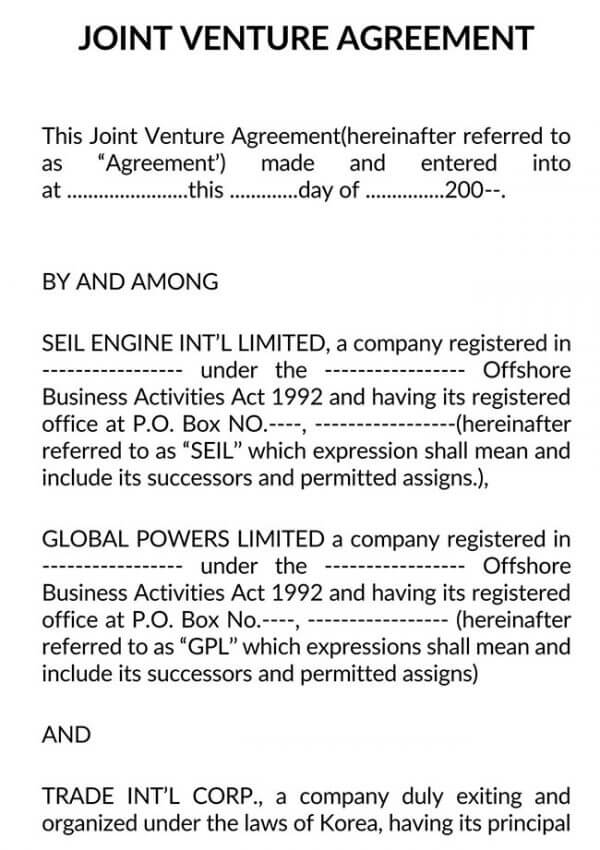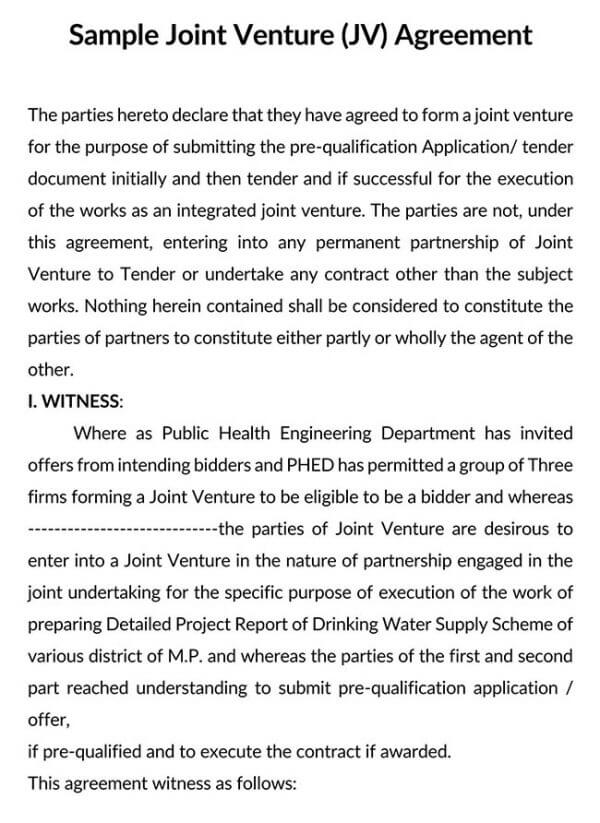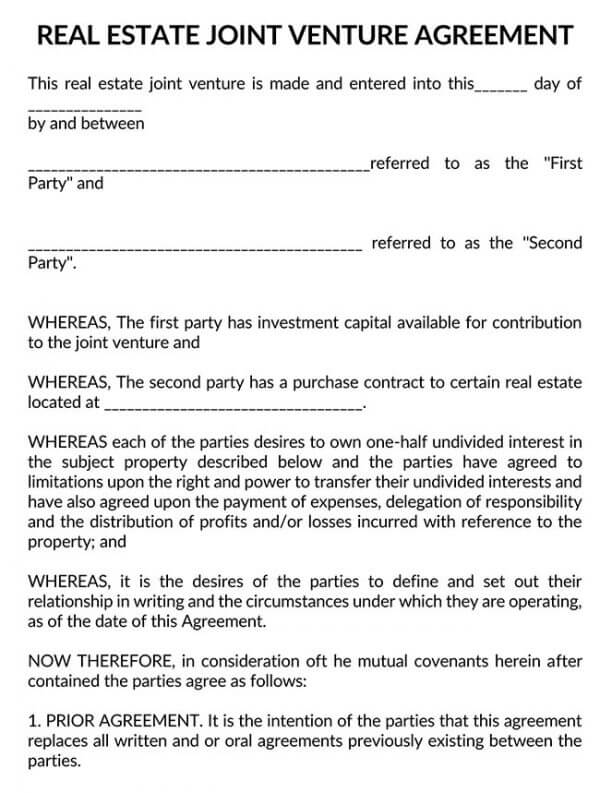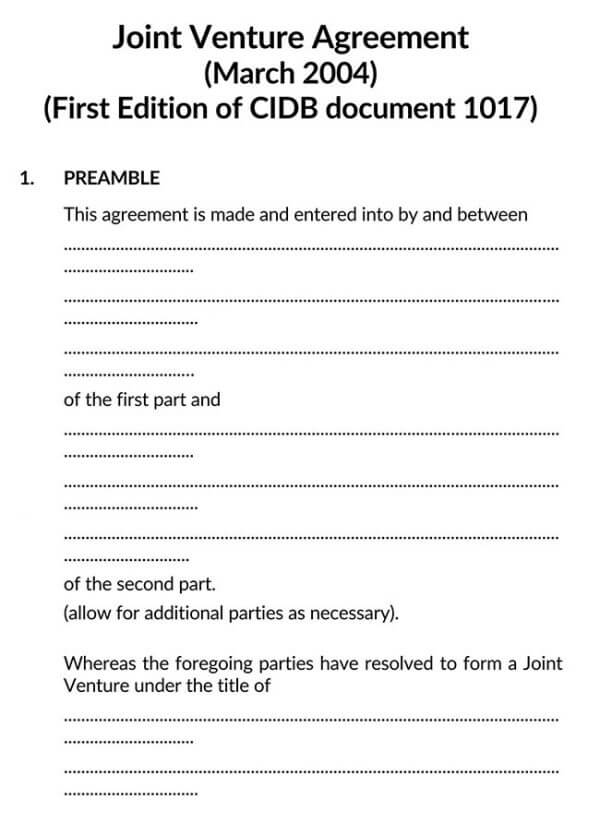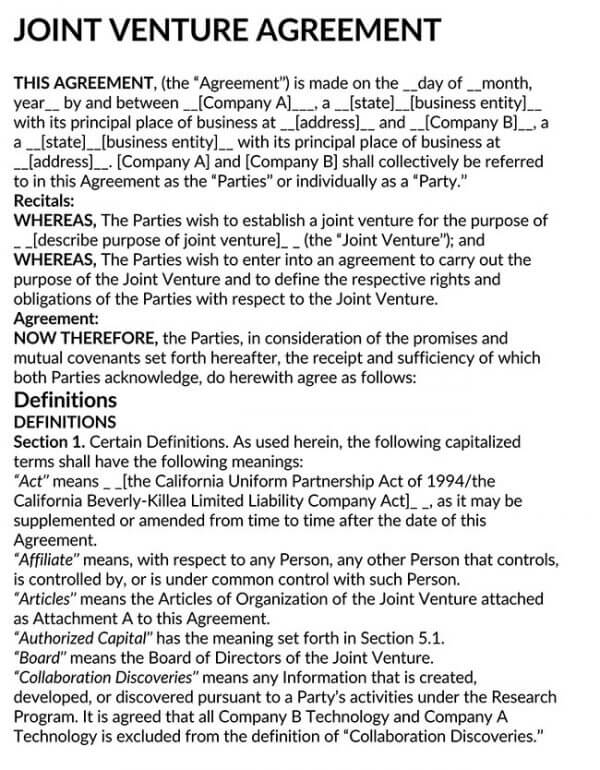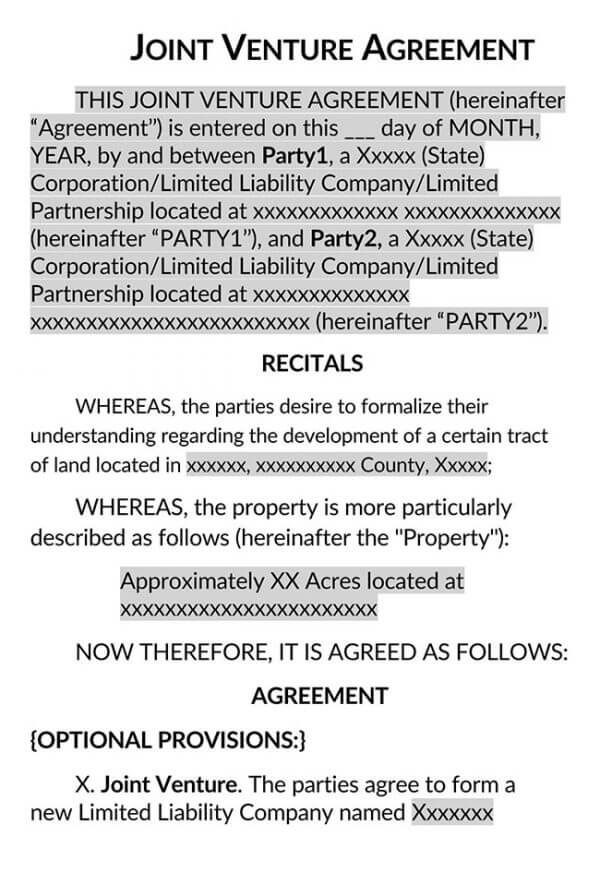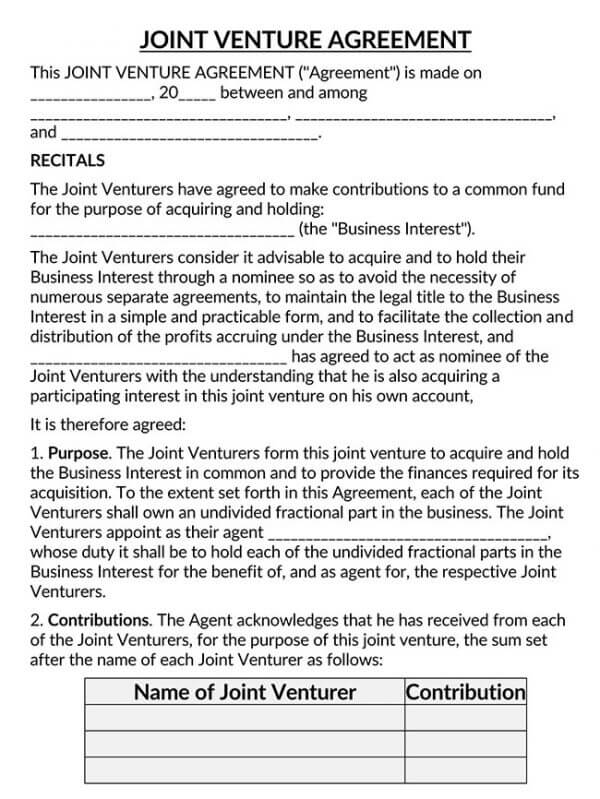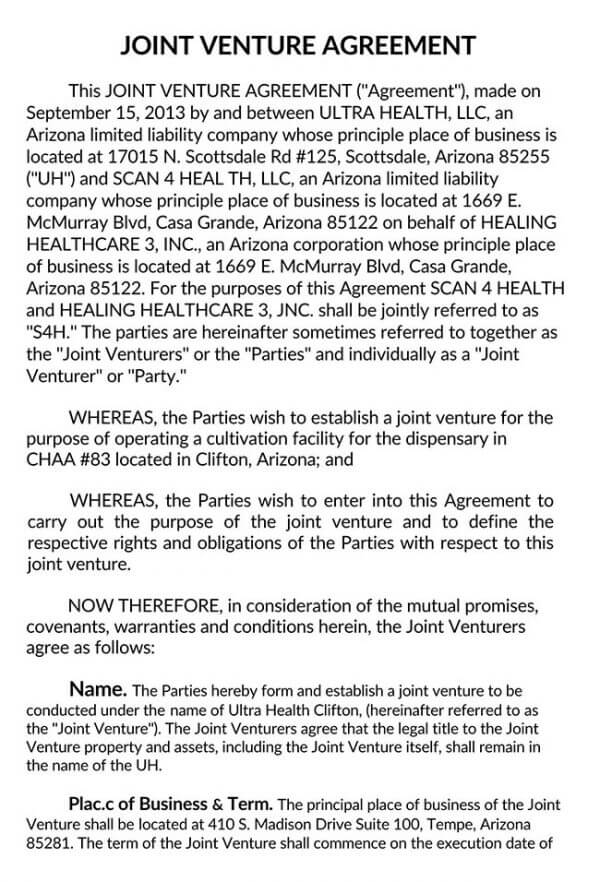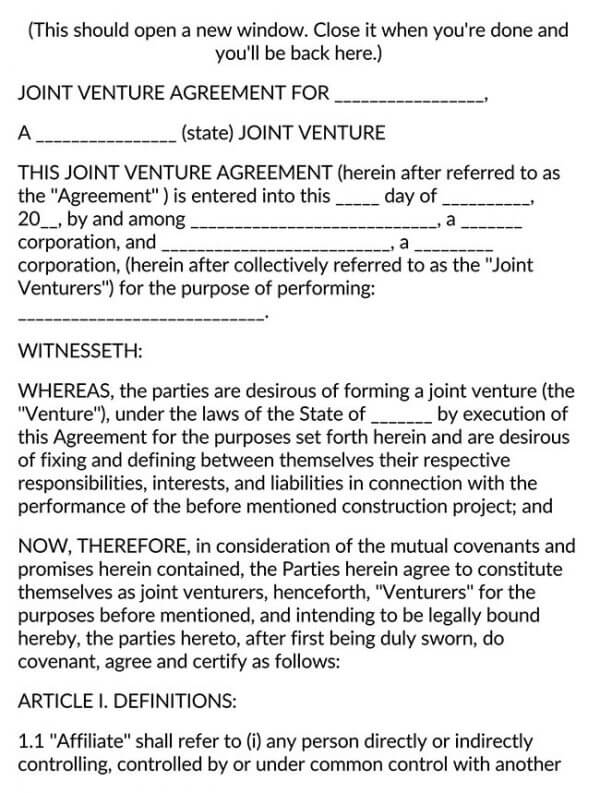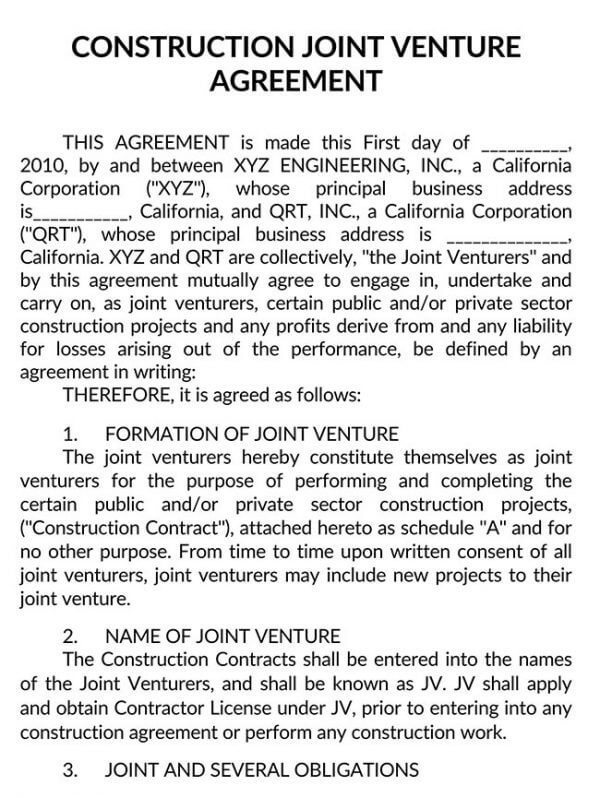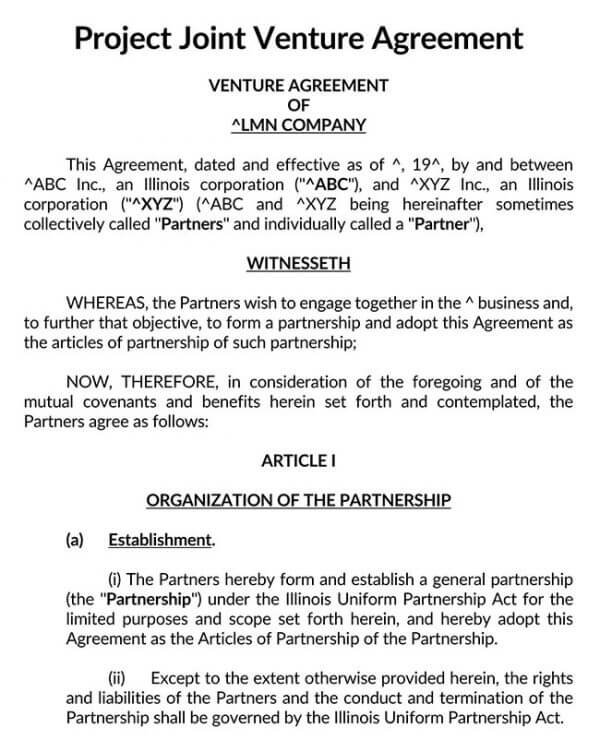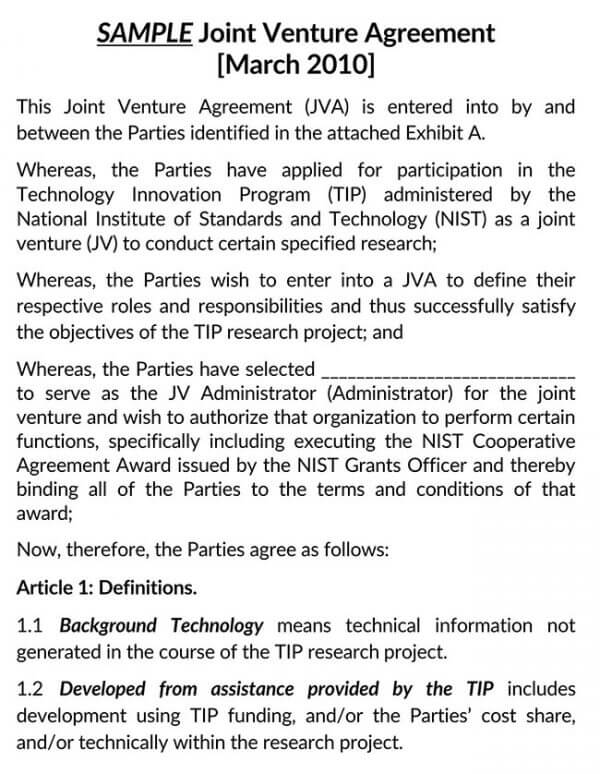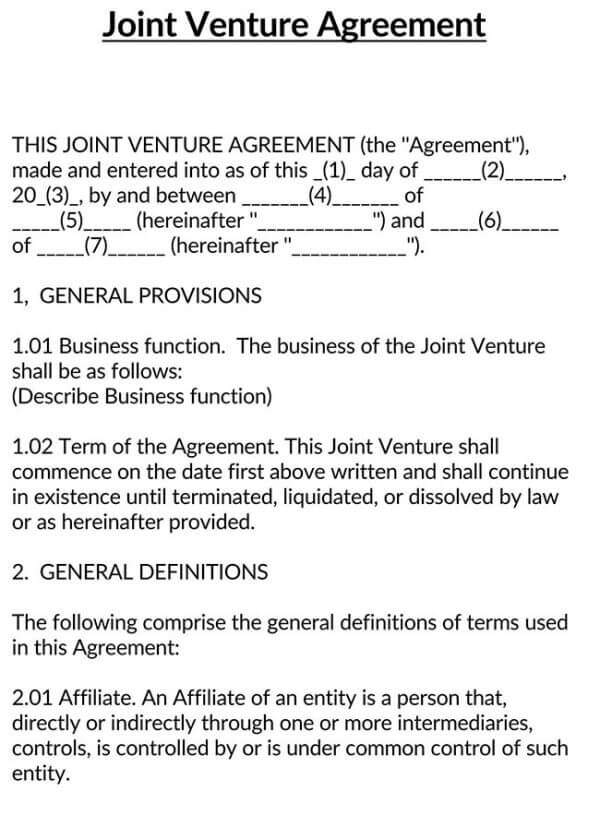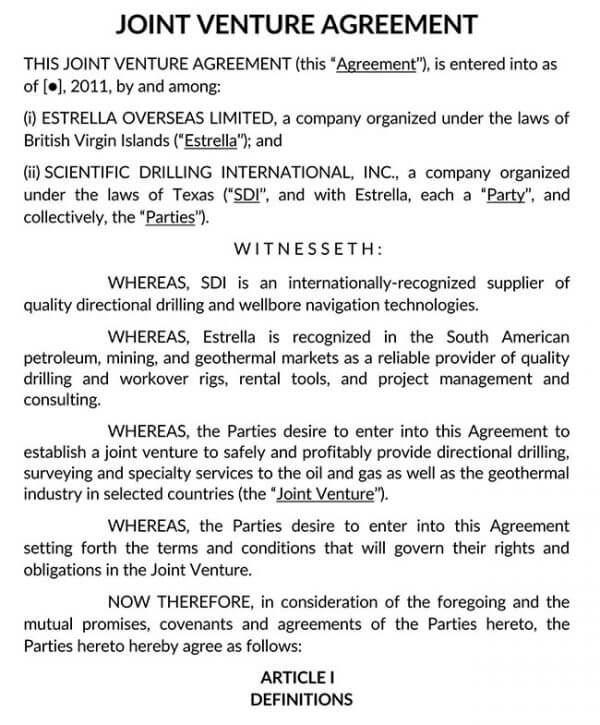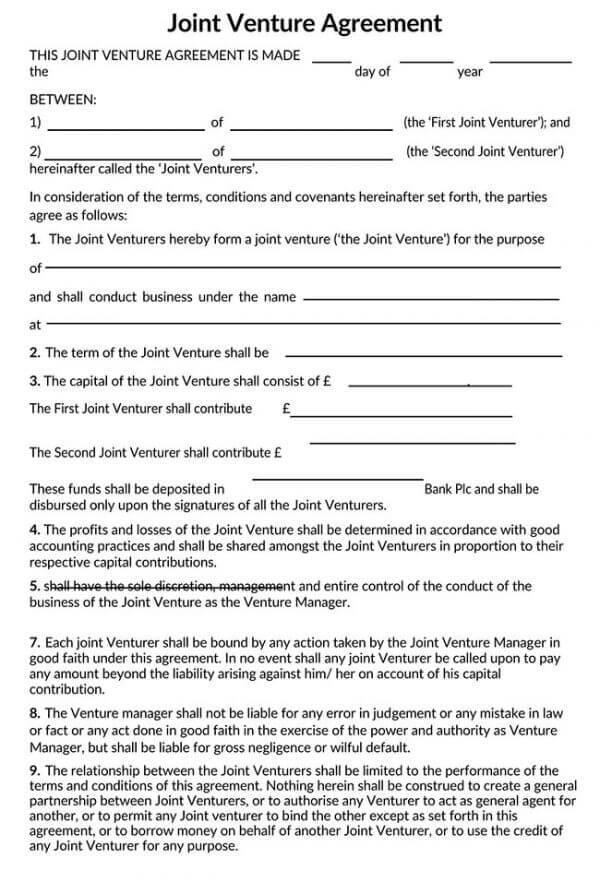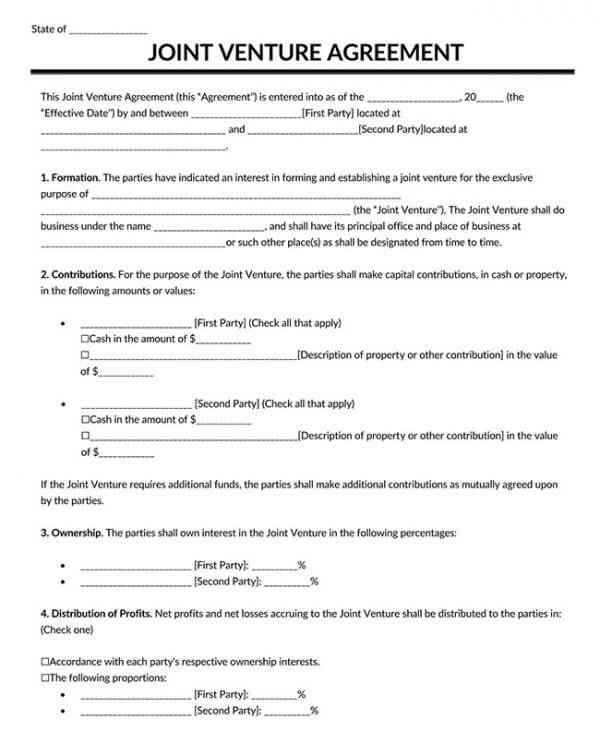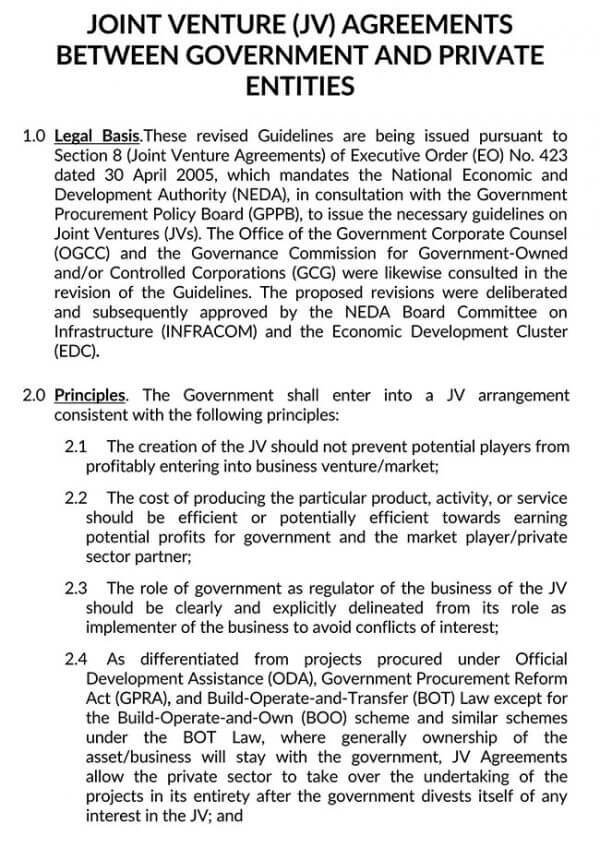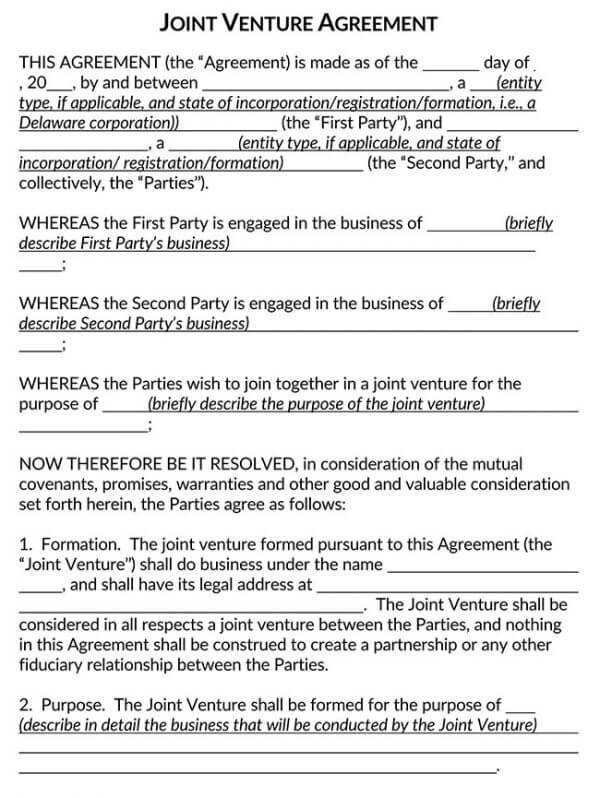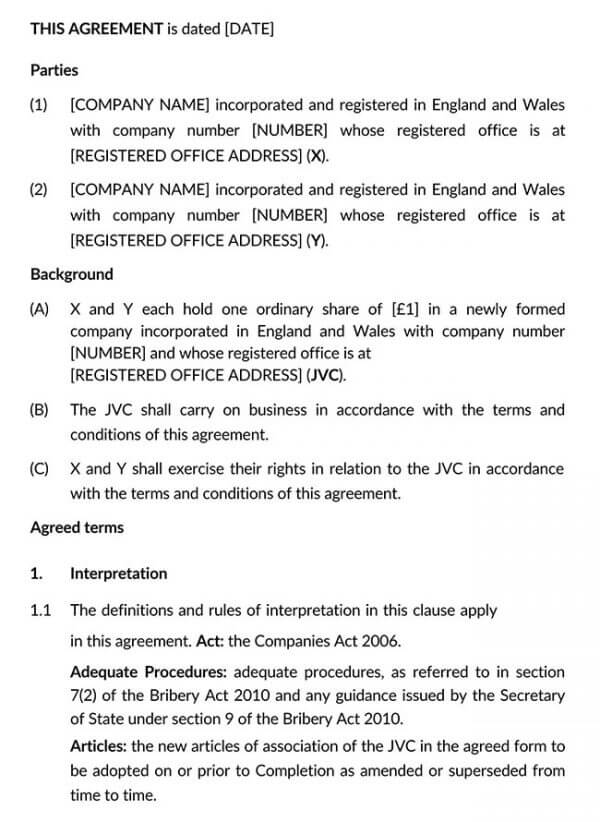Joint Venture Agreements are contracts between two or more parties who want to carry out business as a partnership for a specified period of time. A joint venture has a limited lifespan and specific purposes, and as such, it requires less commitment than a more permanent form of partnership which imposes more obligations and responsibilities on each party.
A joint venture agreement allows concerned parties to continue filing their tax returns separately as opposed to creating a formal partnership or new legal entity which requires them to file their tax returns together. All parties involved can still reap all the financial benefits of a partnership like sharing risks and resources.
Joint Venture Agreement- an Overview
The purpose of a joint venture agreement is to define the terms between the members of a joint venture. In order to do this, a joint venture agreement should outline the project or object of the joint venture as well as the operational and financial contribution of each member. Furthermore, the joint venture agreement should clearly define the products and services of the joint venture as well as the purpose and objective of the joint venture, the duration for which the contract is valid, all concerned parties, and the distribution of any expenses or revenues of the joint venture. Intellectual property is also to be developed by partners involved in the joint venture while daily management procedures as well as solutions to any issues or challenges that may arise.
Alternate names
The joint venture agreement is also referred to by several other terms in oral and written communications.
These are the alternative names for a joint venture agreement:
- Cooperative Agreement
- Consortium Agreement
- Co-venture Agreement
- Joint undertaking
- JV Agreement
- Strategic alliance.
Crafting a Joint Venture Agreement
When putting joint venture agreements together, foregoing and fundamental mutual component and commitment are set in the agreement which requires adherence from both parties. Here are the important steps to consider when crafting a joint venture agreement.
Examine the scope and purpose
The first step to craft a joint venture agreement is to thoroughly examine the purpose and scope of the joint venture agreements. The purpose for which all parties involved in the joint venture agreement have agreed to pull together their resources and share the risks involved in this venture should be examined and clearly stated.
Look for potential partners
The sender company may have to carry out some research to find the best-suited organizations or individuals that can help achieve the set goals of the venture.
By building relationships and networking with other businesses, the sender company can find out more about the organizations and their business. This is an effective strategy for beginning organizations as it will help the organization learn a lot in the process and make it easier to call upon a partner when the time comes.
Letter of intent
The sender company needs to craft a letter of intent as the first step in forming an official joint venture agreement. The letter of intent should contain the purpose of the planned joint venture as well as the sender company’s intention to negotiate the term of the joint venture agreement.
The letter of intent and joint venture agreements are important business documents that must be properly written, and as such, we have provided comprehensive, well-researched, and customized templates to provide your business or organization with the best and most effective letter of intent and joint venture agreement templates.
Formation
The formation of the joint venture should have been established in an abstract context and an informal agreement should have been met before crafting a formal joint venture agreement between all parties involved in the venture. All parties must have come together and clearly state their objectives and purpose for establishing the joint venture.
Names of parties
All concerned parties in the Joint Venture should be named formerly and recognized therein as participating parties in the joint venture.
Create a new entity
The purpose of the joint venture agreement is to create a temporary new entity controlled by all parties in the agreement. Hence the next step is the creation of the said entity. For larger projects, all parties involved in the joint venture may need to create a new corporation or organization. With this new entity, there should be a new identity and a personnel structural hierarchy, however, employees may overlap from two or more partner companies
Draft a sample
In the event that they are smaller or temporary projects to be undertaken by the joint venture, the sending company should draft a sample for such smaller or temporary projects. For smaller projects, the partners should remain in their separate companies and form a joint venture partnership wherein there is no need to merge with another party. The joint partnership agreement would then establish how the partners would share liabilities, profits, and responsibilities.
Introduce the purpose
The next step is to introduce the main purpose of the joint venture agreement. The main purpose is the precise goal for which the joint venture is being established.
Establish all the important terms
All parties involved are required to agree on the terms of the joint venture agreement. Once agreed upon, the terms of the joint venture agreements should be clearly established in the written agreement, clearly describing the obligations and expectations of all parties involved.
Lay out the goals
The goals and objectives for which the joint venture agreement is being crafted must be explicitly stated including all details concerning all parties involved.
Lay out the formation
The joint venture agreement should contain a paragraph forming the joint venture by stating:
The joint venture formed by this agreement (the “joint venture”) will conduct its business under the name {name of the joint venture}, and we’ll have its registered address at {official address of the joint venture}. The joint venture shall be considered a joint venture between the parties in all respects and in no event shall this agreement be construed to create a partnership or any other relationship between the parties involved.
Distribution of profits
All net income earned by the joint venture shall be distributed equally to the parties involved.
Contributions
For a joint venture to be functional, all parties involved have to make financial contributions towards the establishment and execution of the joint venture. The joint venture agreement should contain a statement as follows:
The parties mentioned herein shall each make an obligatory initial contribution to the joint venture as follows;
{Sender company}’s contribution:
{Signer company}’s contribution:
A bank account at {bank name} shall be opened by {sender company} on behalf of the joint venture, and the financial contributions of all parties involved shall be deposited by the due date set forth above. In the event that the joint venture requires additional funding, additional financial contributions shall be made equally by all parties.
Download Free Templates
Here are free and customized templates to download:
Dissolution of Joint Ventures
The joint venture is not a formally organized partnership and as such the joint venture is not permanent and therefore liable to dissolution under the following conditions:
- One company buys the other business.
- New goals developed.
- Market conditions change.
- Shared goals no longer apply.
- The purpose has not been fulfilled.
- Propose has been fulfilled.
- Time for the business relationship has lapsed.
Benefits of a Joint Venture Agreement
A joint venture established for a limited period of time and specific purpose increases the chances of success for a business that stands to benefit from sharing resources with another company. Companies enter into joint venture agreements in the following circumstances and for the following benefits:
Chance to learn new things
Because the joint venture involves two or more companies coming together and pulling together their resources skills and knowledge in the pursuit of a common goal, all parties involved in a joint venture agreement stand to learn new things during the operation of the joint venture.
Access to better resources
Smaller companies typically have limited resources. However, when they enter into a joint venture with a substantially larger company, they gain access to better resources.
Equal share in risks and benefits
As with every other business endeavor, a joint venture has its own risks and rewards. All companies involved in the joint venture have an equal share of the risks as well as an equal share of the benefits from the joint venture.
Flexible terms
The terms of the joint venture have to be agreed upon by all parties involved and as such must be established to satisfy the preferences of all parties involved. Hence the terms of a joint venture agreement are quite flexible and I usually specific to the agreements between all parties.
Buy business from each other
A joint venture agreement may also lead to companies buying business from each other. If a larger company goes into a joint venture with a smaller company, the larger company gets a chance to gauge the operations and efficiency of the smaller company and decide whether or not they want to acquire the company.
Smaller business credibility increases
When a smaller company goes into a joint venture with a larger company, the credibility of such a smaller company may improve within the industry especially when the set goals of the joint venture have been met or exceeded.
New contacts and connections
By pulling together the resources personnel and customer base of both companies, each company that enters into a joint venture agreement stand to gain new Connections and contacts both from the customer base of the other company and from new associates, clients, and customers of the joint venture.
Saving money
A joint venture agreement requires all parties involved to contribute financially towards the execution of the joint venture, with each party bearing a fraction of the cost. Companies can save some money when the financial burden of the venture is shared with the other party.
Meeting new people
Joint ventures typically involve both companies exploring new business opportunities together, as a consequence, all parties involved are exposed to different people from various backgrounds and cultures.
Access bigger markets
Due to the benefits of partnering with larger companies, smaller companies and businesses can access larger markets and bigger clients.
Develop new technologies
With the combined financial resources and manpower of two businesses, new technologies can be developed by facilitating the goals of the joint venture agreements.
Exposure across international borders
When a local and foreign company enters a joint venture, the local company can learn about the local security of a local area from the foreign company, while the foreign company will be exposed to new experiences and expertise from the local company.
Develop new products
When two companies collaborate to form a joint venture, the joint venture may be outside the core business of one or both companies, and as such, the company can establish a new product or service outside their core business.
Expand business
A joint venture provides businesses and companies with the opportunity to expand their business by taking on another entity while sharing the risks and benefits with another body.
Profiting from other businesses
The essence of the joint venture is to serve as a secondary means of profit for the business or company. Although the benefits are shared by all parties involved however the prophets remain substantial especially when compared with the risks involved.
Reduce costs
The very nature of a joint venture is to split the cost of establishing a new business venture between two or more businesses. A single business or company would not be required to take on the full financial responsibility of setting up a new business venture. instead, all the parties involved have to pitch in their financial contributions towards the execution of the business venture.
Share expertise for future growth
With different businesses and organizations comes a varying level of expertise. However, if these organizations come together to form a joint venture a consequence of this is that they will share their expertise with the other parties making way for future growth opportunities in all the parties involved.
Access to new research materials
When a larger company forms a joint venture with a smaller company, the larger company will benefit from new research materials from the smaller companies, as smaller companies would be more recently established and utilize more recent information as a result.
Risks of Forming a Joint Venture
As with any other business endeavor, entering into a joint venture agreement exposes a business or organization to certain risks which are as follows:
Unclear business objectives
A joint venture is an entity formed from two or more existing business entities. The objective behind entering into a joint venture is unclear to the other parties involved. Although all parties show shares a common goal and bear the financial responsibilities and risks.
However, the primary business objective for entering into the joint venture agreement is not entirely clear to other parties involved in the joint venture.
Miscommunication
In the operation of the joint venture, all parties involved are required to communicate regularly with one another. However one of the risks of communication is miscommunication either deliberate or not.
Asymmetric business relationship
Typically, parties involved in a joint venture do not operate on the same scale neither do they have the same level of resources at their disposal. Hence the business relationship between all parties involved in the joint venture may not be symmetrical with one company being substantially larger than the other.
Loss of investments
The joint venture is typically an investment for all organizations involved. With all investments, the desired outcome is “returns”. However, there is a significant risk of a total loss of investments or delayed returns as the joint venture may not meet up the projected expectations.
Joint Venture Agreement vs Partnership
The collaboration between two business organizations, without a joint venture agreement, may be assumed to be an actual legally recognized partnership and as a result subject to the default state laws for tax and liability purposes.
There are quite a few differences between a joint venture and a partnership some of which are listed below;
| Partnership | Joint Venture |
|---|---|
| All business entities involved are joined on a permanent basis for an indefinite period. | The shared obligations are valid on a temporary basis. |
| A new legal entity is created | This is merely a contractual relationship between two organizations or individuals |
| Involves broad purposes and scope. | The scope and purpose is limited |
| Tax returns are filed jointly. | Tax returns are filed individually |
| All parties are jointly and severally liable for debts | Each Co-Venturer has individual liability |
| All concerned parties have a broad fiduciary duty to the partnership | All concerned parties have limited fiduciary duty to the joint venture |
| Partners may sign contracts as agents | All concerned parties must sign contracts |
| Ownership percentages are divided equally by default. | Ownership percentages are subject to individual financial contributions towards the establishment of the joint venture. |
Types of Joint Venture Agreements
Businesses and organizations looking to enter into a joint venture agreement have quite a few choices to pick from. The type of joint venture agreement depends largely on the purpose of the joint venture and the objective the joint venture is meant to achieve. A joint venture would have to be agreed upon by separate parties seeking to achieve the same goal for their own benefits. Here are different types of joint:
Joint venture agreement (type 1)
This type of joint venture agreement is used when two separate parties agreed to work on a single business project or business activity. Both concerned parties are required to agree on the terms and rules of the joint venture agreement. Once the project or activity is done the joint venture agreement expires.
Joint venture entity
In this type of joint venture agreement, a new organization or company is created by two separate and usually smaller companies. The main parties involved in this type of joint venture usually become shareholders of the new company and then serve to conduct the business of the joint venture.
Marketing joint venture
When two parties come together with an agreement for the purpose of selling their products or services this type of joint venture is formed. The main purpose of a marketing joint venture is to reduce the marketing efforts and costs while gaining a wider market and reach for the products or services offered by both businesses. If for instance, two business organizations decide to print their brochures and flyers with combined advertisements, share ad spaces, share websites all co-host and produce events seminars or press releases, both businesses will be said to be in a marketing joint venture.
Offshore joint ventures
An offshore joint venture is formed when a parent company made an agreement with its branches or smaller companies to transfer resources (technology for instance), market their products and services domestically, or secure their international rights.
Frequently Asked Questions
What is a joint venture agreement?
A joint venture agreement is a business document and legally binding contract that establishes the terms obligations and commitments of a joint venture between two or more parties.
What is the best way to structure a joint venture?
The best way to structure a joint venture is to follow the steps outlined in this article or download our free customized templates.
What should be included in a joint venture agreement?
A joint venture agreement must contain important elements including the scope and purpose of the joint venture terms of the joint venture agreement the duration for which the joint venture remains valid and the obligations of both parties involved in the joint venture.
How do you terminate a joint venture agreement?
A joint venture agreement can be terminated at the end of the term of the joint venture or if the joint venture has achieved the goal for which it was set up. If the joint venture does not achieve the goal for which it was set up and both parties mutually agreed the joint venture may be terminated.
Can you dissolve a joint venture?
For a joint venture to be dissolved, both parties involved have to mutually agree to dissolve the joint venture or if the term of the joint venture has expired one of the concerned parties may dissolve the joint venture by electing not to renew the terms.
